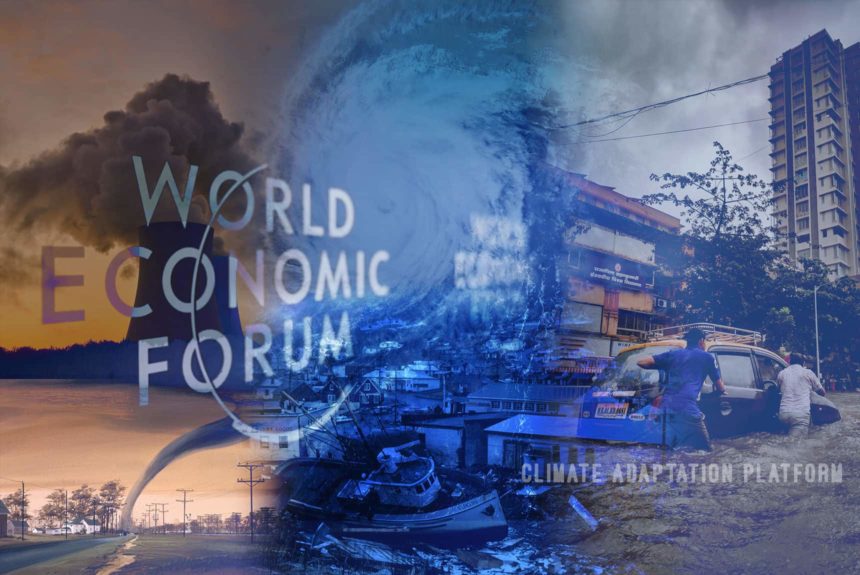Climate change-related risks top the World Economic Forum’s (WEF) Global Risk Report 2022 17th Edition. Climate action failure, extreme weather, and biodiversity loss as the top 3 global risks.
Human environmental damage and natural resource crises are at number 7 and 8, respectively, according to the nearly 1000 experts and leaders in business surveyed by the report.
The WEF started conducting and publishing the Global Risks Perception Survey (GRPS) in 2006. This year’s 17th Edition gathers new and broader insights from global experts and leaders who responded to the survey.
Two years into the Covid-19 pandemic, infections due to the Omicron variant are spreading, but the pandemic pales in comparison with the long-term threats that climate change poses.
According to the report, taking all the Nationally Determined Contributions (NDCs) of countries submitted during the COP26 in Glasgow places the world in a 2.4°C trajectory with the most optimistic scenario at a 1.8°C course, well above the 1.5°C Paris Agreement.
The Executive Summary says that disorderly climate transition will exacerbate inequalities. It further says:
“Climate change is already manifesting rapidly in the form of droughts, fires, floods, resource scarcity and species loss, among other impacts. In 2020, multiple cities around the world experienced extreme temperatures not seen for years—such as a record high of 42.7°C in Madrid and a 72-year low of -19°C in Dallas, and regions like the Arctic Circle have averaged summer temperatures 10°C higher than in prior years”.
Most respondents to the survey believe that too little is being done about the climate – 77% of them says that international efforts to mitigate climate change have not started or are in early development. They believe the failure to respond to climate change is the most critical threat to the world, affecting economies and damaging societies between five to over ten years from now.
Chapter 2 of the report, Disorderly Climate Transition, mentions that while the Covid lockdown has slowed down GHG emissions, it soon resumed an upward trajectory and even higher in 2020 than the average in the last decade.
If the world fails to achieve a net-zero goal by 2050, the planet will face very high costs and losses equivalent to 4% and 18% of global GDP with varying impacts across the regions. However, meeting the net-zero targets “could be as transformative for economies and societies as past industrial revolutions.”
The path to decarbonisation presents complex technological, economic, and societal challenges. Additionally, the slow and inadequate current commitments will lead to varying degrees of disorderliness, drive countries apart, and result in losses and damages.
However, the manifestations of climate change will accelerate response from governments, businesses, investors, communities through a plethora of regulations and policies such as carbon border taxes, climate risk disclosure frameworks, international sustainability standards to clarify what needs to be done and prevent greenwashing.
Some big businesses deliberately stall green transition efforts, and distrust about climate science remains pervasive in many countries. At the same time, both developed and emerging economies still invest heavily in carbon-intensive technologies and continue to receive public subsidies.
When writing the report, the economic rebound from Covid-19 has seen energy demand surpass supply, which sharply raised its prices even as the world wants to transition to renewables.
Hence, governments have a crucial role in balancing the needs of populations dependent on carbon-intensive industries with international commitments.
The chapter closes with insights on how to move towards a more sequenced transition. It says:
- The challenges of the climate transition stemmed from decades of inaction and the hesitant implementation of transition measures.
- In a recovering yet diverging global economy, the transition will need to be at varying paces to prevent short-term disruptions from offsetting long-term gains, but the consequences of disparate transition will be felt worldwide.
- The least disruptive climate transition measures will be those that holistically integrate the needs of individuals, societies, businesses and planet.
- Domestic and international collaboration should focus on educating the public about the value and need of climate action, including a change in consumer behaviour and demand-destruction for carbon-intensive goods.
- Businesses of all sizes need to be incentivised to proactively factor in transition risks and move to circular economy models, while governments should be encouraged to take bold and immediate steps towards implementing robust legal frameworks that ensure a just transition.
Read the full report by CLICKING on the link provided in the “Source” below.
Sources:
The Global Risks Report 2022, 17th Edition. (2022). World Economic Forum. Retrieved from https://www3.weforum.org/docs/WEF_The_Global_Risks_Report_2022.pdf
Global Risks Report 2022: What you need to know. (2022, January 11). World Economic Forum. Retrieved from https://www.weforum.org/agenda/2022/01/global-risks-report-climate-change-covid19/



Leave a Reply